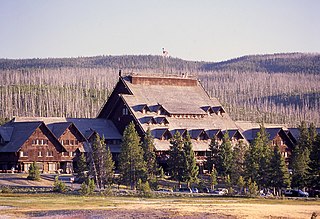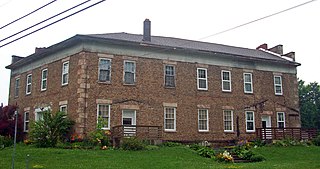
The Old Faithful Inn is a hotel in the western United States with a view of the Old Faithful Geyser, located in Yellowstone National Park, Wyoming. The Inn has a multi-story log lobby, flanked by long frame wings containing guest rooms. In the western portion of the park, it sits at an approximate elevation of 7,350 feet (2,240 m) above sea level.

Barboursville is the ruin of the mansion of James Barbour, located in Barboursville, Virginia. He was the former U.S. Senator, U.S. Secretary of War, and Virginia Governor. It is now within the property of Barboursville Vineyards. The house was designed by Thomas Jefferson, president of the United States and Barbour's friend and political ally. The ruin is listed on the National Register of Historic Places.

Pahaska Tepee is William "Buffalo Bill" Cody's old hunting lodge and hotel in the U.S. state of Wyoming. It is located 50 miles (80 km) west of the town of Cody and two miles from the east entrance to Yellowstone National Park.

The Lake Hotel, also known as Lake Yellowstone Hotel is one of a series of hotels built to accommodate visitors to Yellowstone National Park in the late 19th and early 20th century. Built in 1891, it is the oldest operating hotel in the park. It was re-designed and substantially expanded by Robert Reamer, architect of the Old Faithful Inn in 1903. In contrast to the Old Faithful Inn and many other western park facilities, the Lake Hotel is a relatively plain clapboarded Colonial Revival structure with three large Ionic porticoes facing Yellowstone Lake. It was designated a National Historic Landmark in 2015.

The Old Faithful Historic District in Yellowstone National Park comprises the built-up portion of the Upper Geyser Basin surrounding the Old Faithful Inn and Old Faithful Geyser. It includes the Old Faithful Inn, designed by Robert Reamer and is itself a National Historic Landmark, the upper and lower Hamilton's Stores, the Old Faithful Lodge, designed by Gilbert Stanley Underwood, the Old Faithful Snow Lodge, and a variety of supporting buildings. The Old Faithful Historic District itself lies on the 140-mile Grand Loop Road Historic District.

The Dearborn Inn, A Marriott Hotel, is a luxurious historic hotel, conceived by Henry Ford, who saw a need for food and accommodations for visitors flying into the nearby Ford Airport, making it one of the first airport hotels. It is located in Metro Detroit at 20301 Oakwood Boulevard in the suburban city of Dearborn, Michigan near The Henry Ford and the world headquarters building of Ford Motor Company. Albert Kahn designed the Dearborn Inn in the Georgian architectural style. The Dearborn Inn is owned by Ford Motor Land Development Corporation and managed by Marriott International.
The Stock Center in Cody, Wyoming was built in 1927 as the original home of the Buffalo Bill Museum, serving in that purpose until the museum was relocated to a new complex across the street. The log structure is intended to suggest a stockman's log cabin, rendered on a large scale.

The Cambria Casino, also known as the Flying V Guest Ranch and the Cambria Casino Park-Memorial, is a resort on the western edge of the Black Hills in Weston County, Wyoming. The resort was named for Cambria, a nearby coal-mining community. The two-story sandstone lodge, designed by New York architect Bruce Rabenold, employs English Tudor and other medieval details to create a Tudor manor-like setting in the Wyoming hills. The lodge fronts on a court, entered through a gatehouse and originally flanked by wings housing guest rooms. The property is significant as an example of a unique eclectically style resort in eastern Wyoming. A portion of the casino was intended to serve as a memorial to Cambria-area miners.

The Masonic Temple in downtown Casper, Wyoming is a Masonic hall, built in 1914 during a boom time initiated by the development of the Salt Creek Oil Field. Located on a corner site, the temple remains essentially as it was designed by Casper architect Homer F. Shaffer. The four story light-colored brick building rests on a raised basement and is topped by a crenelated parapet. The original windows have been replaced with vinyl units but retain the one-over-one appearance of the originals. Windows extend over the west and south sides. The north side is blank, while the east side is the building's rear facade and has fire escapes and a few windows.

The Cobblestone Inn is located along Ridge Road in Oak-Orchard-on-the-Ridge, an unincorporated hamlet in the Town of Ridgeway, New York, United States. It is a cobblestone building dating to the 1830s.

The Enchanted Valley Chalet is a backcountry lodge in Olympic National Park. The chalet was built in 1931 by Tom E. Criswell, his son Glen and the Olson family of Quinault whose Olympic Recreation Company operated it as a destination lodge deep up the Quinault River Valley, about 13 miles (21 km) from the nearest road access. Under the Olsons' ownership through the 1930s, and for decades under the National Park Service, the chalet has endured as a destination in its own right. It was a popular destination for hikers and horse tours through the 1940s. In 1943, the chalet was closed as an accommodation. It was used for a short period as an Aircraft Warning Service station during World War II, watching for Japanese airplanes. It did not reopen until 1953, after the National Park Service had purchased the Olympic Recreation Company's holdings in 1951, having purchased the Chalet itself in 1939. After a period of neglect, the chalet was restored in 1983-84. It was one of four such accommodations built by the Olympic Recreation Company and the Olympic Chalet Company; Low Divide Chalet, Nine Mile Shelter, Graves Creek Inn and the Enchanted Valley Chalet. Of the four, only the Enchanted Valley Chalet and the bathhouse at Low Divide remain.

The Kimball Towers Condominiums is a historic former hotel, located in Springfield, Massachusetts, at 140 Chestnut Street, in Metro Center's Apremont Triangle Historic District. Designed by architect Albert Winslow Cobb in 1910 and constructed in the Renaissance Revival style, The Hotel Kimball is famous as the site of the United States' first-ever commercial radio station, Westinghouse's WBZ, and also for hosting celebrated guests, including many U.S. Presidents, dignitaries, and film stars. The Kimball is located in the Apremont Triangle Historic District, with its main entrance on Chestnut Street, between Bridge and Hillman Streets. Since 1983, the Kimball has been protected by the Apremont Triangle Historic District, which is on the National Register of Historic Places. During 2012 and 2013, renovations will be carried out in accordance with the Historic Preservation Certification.
Neltje, also known as Neltje Doubleday Kings, was an American artist, businesswoman and philanthropist. In 2005 Neltje received the Wyoming Governor's Art Award for her artwork; she was an abstract painter.

The Heber Hord House is a two-story frame house in Central City, Nebraska. It was designed by Omaha architects Fisher and Lawrie, and built in 1906 by Heber Hord, the only son of Thomas Benton Hord, a prominent business man and cattle rancher in Nebraska during the late 19th and early 20th centuries. It is listed in the National Register of Historic Places.
The Chamberlin Inn is a historic Cody, Wyoming hotel and landmark, known famously as the hotel where Ernest Hemingway stayed and finished his manuscript, Death in the Afternoon. Located at 1032 12th Street in downtown Cody, Wyoming the small boutique hotel is 21 units made up of a series of suites, rooms, cottage and garden studios, as well as the Court House Residence, all within a brick and wrought iron courtyard.

The Holderness Inn is a former 19th century hotel building on United States Route 3 in Holderness, New Hampshire. Built in 1895–96, it is the only such building standing in the Squam Lake area, from a period when there were a significant number of resort hotels around the lake. The building was listed on the National Register of Historic Places in 1984. It is now owned by the Squam Lakes Natural Science Center, and is open seasonally as an art gallery and craft showroom.

The Hotel Wolf is a hotel and restaurant in Saratoga, Wyoming. The two-story brick building was built at an estimated cost of $6000 in 1893 for Frederick G. Wolf, a German immigrant who had operated liquor stores in Wyoming. It opened for dining with a banquet on New Year's Eve 1893. The hotel opened on January 10, 1894. Two years after Wolf's death in 1910 his widow Christina sold the property to George W. Sisson for $10,000. It continues to operate as a hotel and restaurant.
The Brooks Lake Lodge, also known as the Brooks Lake Hotel and Diamond G Ranch, as well as the Two-Gwo-Tee Inn, is a recreational retreat in Fremont County, Wyoming near Dubois in the upper Wind River valley. The complex was built in 1922 to accommodate travelers coming to Yellowstone National Park on U.S. Route 287 from central Wyoming. The buildings are mainly of log construction with Craftsman style detailing.

The Wolverine Hotel, also known as the Dilworth Hotel or the Wolverine-Dilworth Inn, is a hotel located at 300 Water Street in Boyne City, Michigan. It was listed on the National Register of Historic Places in 1986. It is the only hotel remaining in the Boyne area dating from the turn-of-the-century era when Boyne City was a booming lumber town.

The Carpenter Hotel Historic District comprises a hotel complex near Atlantic City, Wyoming. Also known as the Miner's Delight Inn, the hotel was established by Nellie Carpenter in 1904 with six rooms and a dining room. The hotel was expanded in 1935 with a two-story section and five guest cabins. The hotel housed Atlantic City's post office from 1930 to 1953. The Carpenter family sold the hotel in 1963 following Nellie's death. It continues to operate as a hotel.


















